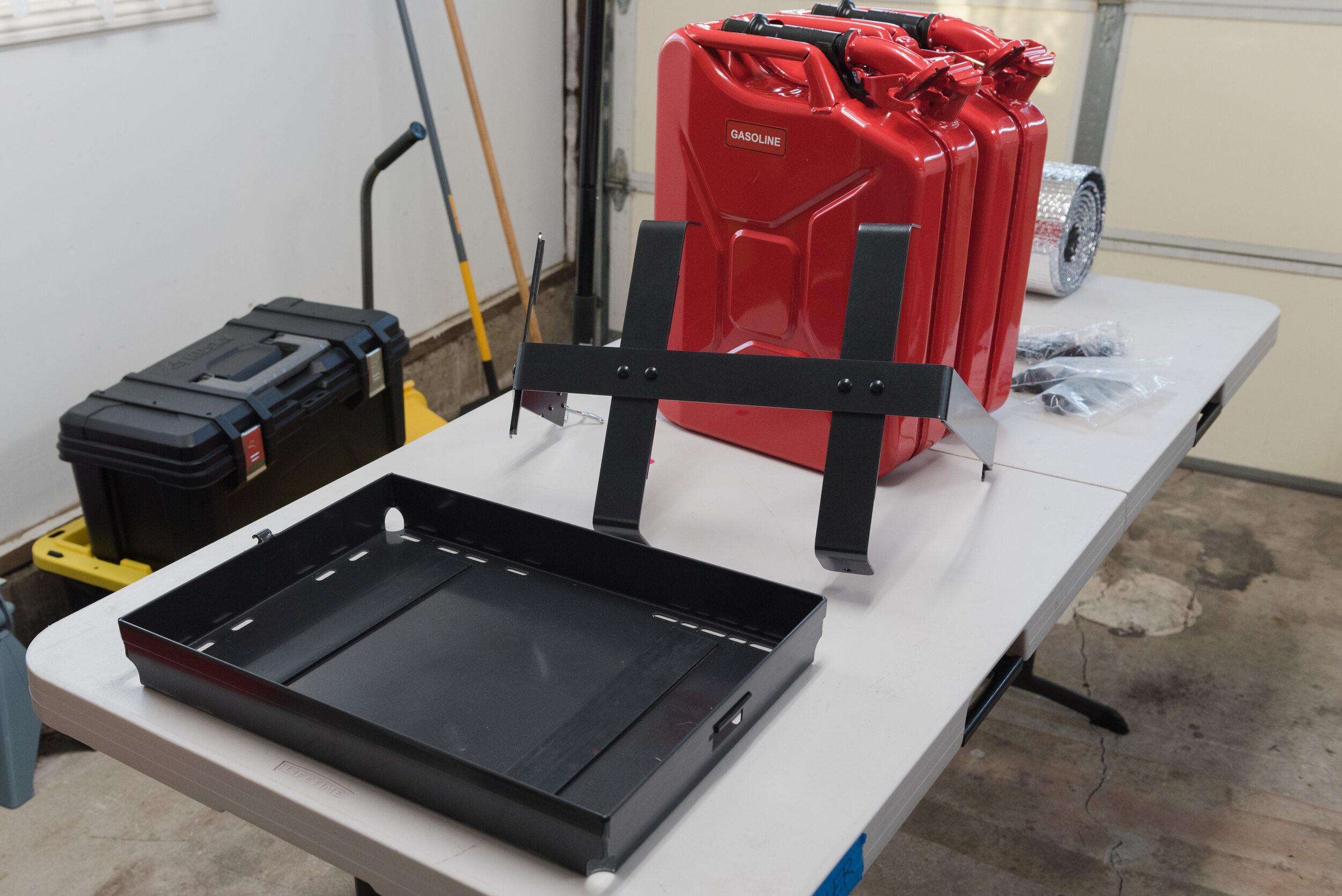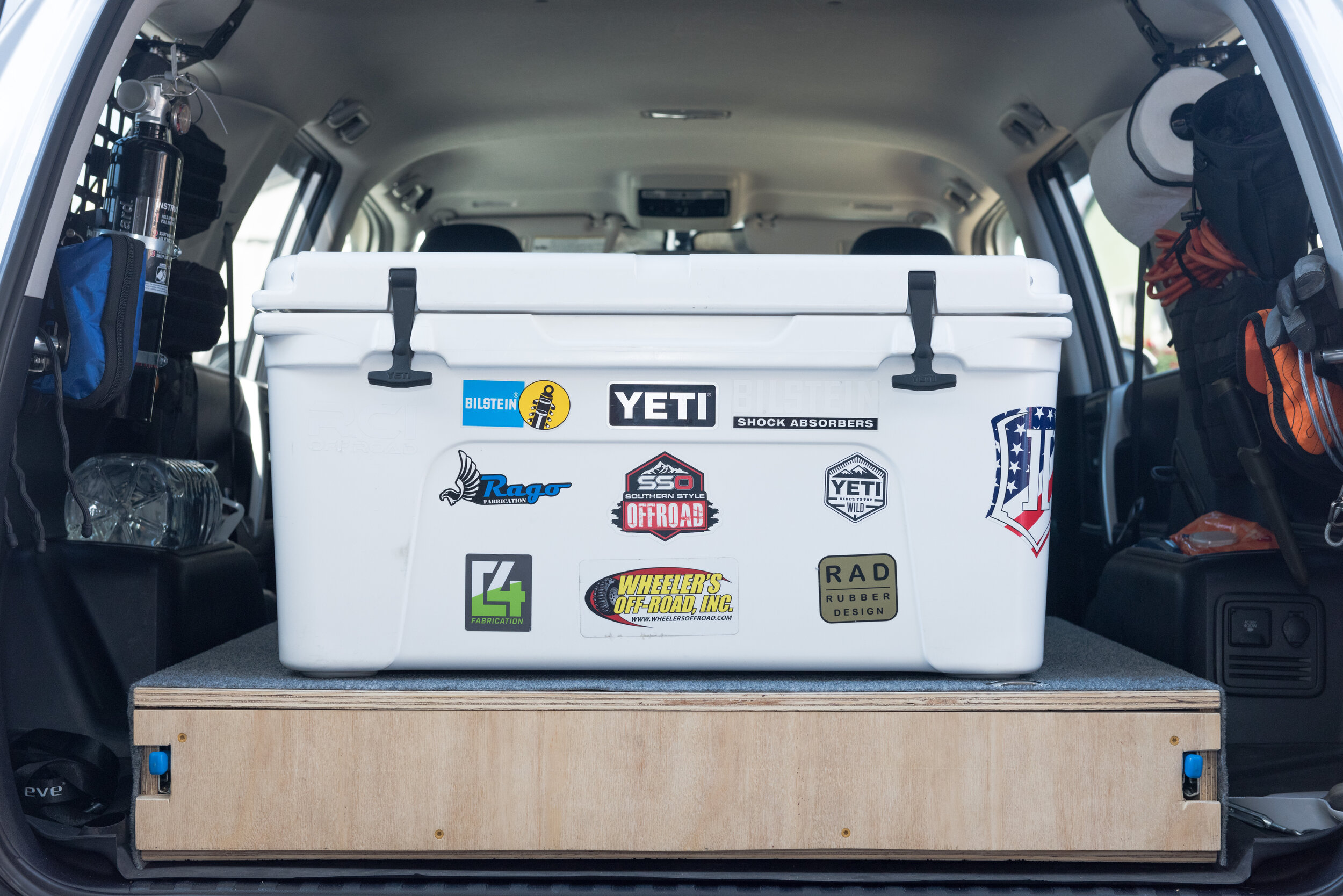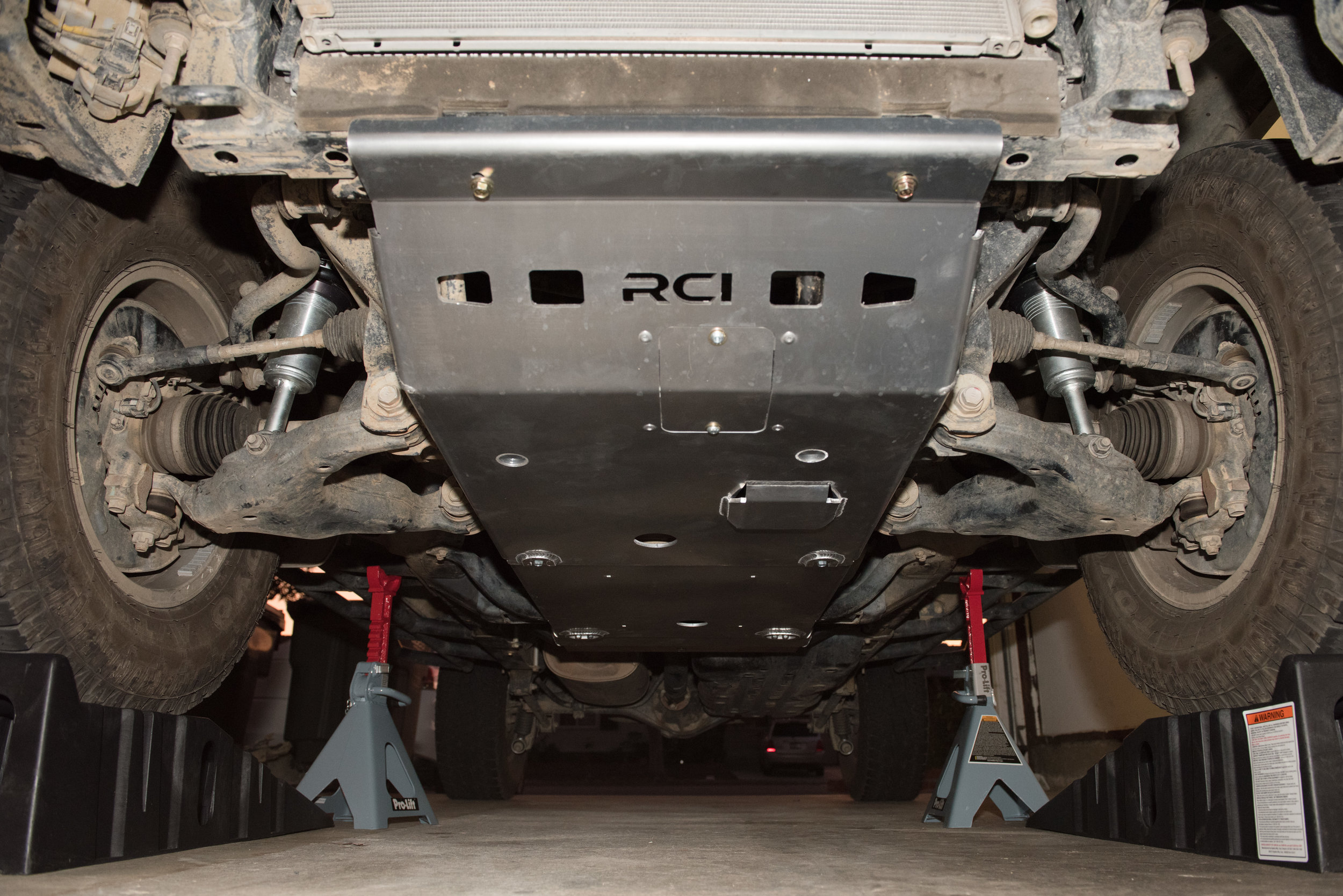Our 4Runner came with OEM running boards from the dealership. After half a year of vehicle ownership and completing a handful of off-road trails (with some sketchy sections), I decided to replace the running boards with proper rock sliders.
In general, when most people think of adding steps to their SUV or truck, they think of installing running boards or nerf bars. As far as I understand it, there is very little difference between these two accessories - most of their difference is in appearance. Both bolt into the rocker panel under the vehicle - usually in at least two locations, sometimes three. However, running boards are often constructed of extruded aluminum and plastic while nerf bars tend to be round tubular aluminum bars. Some running boards are even automatic (!) - lowering and raising from the rocker panel whenever a door is opened. In any case, both setups function well as steps to get into and out of the cabin. However, both designs are more focused on functioning as a step rather than protecting the rocker panel or door of a vehicle (especially on potentially rough off-road conditions or obstacles…).
Rock sliders, on the other hand, are meant to protect a vehicle’s rocker panel from damage whilst “sliding” over obstacles on off-road trails. Some can even function as a step if the outer tube is not set at a high angle. Unlike running boards and nerf bars, rock sliders are made of thick steel tubing and attach directly to the vehicle’s frame - not the rocker panel. They are also supposed to be designed to hold the weight of your vehicle on (surprise!) a rock or other obstacle. Different purpose, different design. Rock sliders generally have four components: mounting plates, a main tube, an outer tube, and supporting tubes. The mounting plate attaches to the vehicle’s frame… supporting tubes attach the main tube (sits about right at the vehicle’s door) to the mounting plates… the two ends of the outer tube are usually bent and welded on to the main tube… and supporting tubes run between the main tube and the outer tube at intervals.
I’m not considering taking our 4Runner over any serious rock crawling obstacles. However, rock sliders are cheap insurance for body damage on any inadvertent drop-offs I encounter on any trails I elect to tackle.
On to sharing some of my limited knowledge on rock sliders! Do your own research before making a decision… I’m still learning and am prone to misunderstanding a concept somewhere down the line. Feel free Contact me if I’ve misstated something. I’m sure there’s a lot of folk with more technical knowledge than myself on this topic.
Bolt-on vs. Weld-on
In general, rock sliders either bolt-on or weld-on to the frame of the vehicle - they are not bolted-on to the rocker panel. Some bolt-on slider make use of existing factory-tapped holes in the vehicle’s frame whereas others may require you to drill additional holes into the frame. Contrarily, weld-on sliders are just that - the sliders are welded directly to the frame of the vehicle. Bolt-on sliders tend to be more expensive than weld-on options, although you might have to pay someone to weld-on the sliders if you’re don’t know how to weld (like myself). Out of simplicity I decided to invest in pure bolt-on rock sliders that did not require drilling additional holes.
One caveat of bolt-on versus weld-on rock sliders is that sand or other fine particulates may sneak into the gap between the rock slider’s mounting plate and the vehicle’s frame. Over time, with on or off-road movement/vibrations, the particulates could damage the frame or rock slider’s protective coating. This will eventually allow rust to form on either surfaces. Bleh, rust. I am from Hawaii and hate rust. We had to deal with rust a lot on the frame of my father’s boat trailer. That was no fun - luckily where I am in California is not as humid or salty as Hawaii.
Annual or semi-annual maintenance and inspections are recommended to check for and treat any frame rust. This is especially important if you live in areas that salt roads in the winter, but a little less of a concern concern in more dry arid climates. However, keep in mind that all bare steel rusts in the presence of water and oxygen! Periodic inspection and maintenance of the undercarriage is recommended, anyway.
HREW vs DOM
Sliders are often fabricated from either round or square steel tubing, or sometimes both. The steel tubing is generally either Hot Rolled Electrically Welded (HREW) or Drawn Over Mandrel (DOM). I’m no metallurgist, but I think if you boil it down to a one-liner it is: HREW is much cheaper than DOM, but DOM is much stronger. I’m not going to go into more detail than that. Other factors such as weld quality, tube inner and outer diameter, and others also lend to overall structural strength
Angle
Angle refers to the angle between the main and outer tube. In general, the main tube is always parallel with the vehicle’s frame. The outer tubes can angle upwards, which helps to provide more ground clearance and better door protection. Common angles include 0-degrees (flat), or 10 to 25-degrees in 5-degree increments. Higher angle outer tubes are less useful as steps.
Filler Plates
Filler plates are meant to “fill” the gap between the main and outer tube. These are helpful for small feet (people or pets) that have to hop in and out of the cabin who may have problems stepping onto the outer tubes. Most filler plates are either bolted, riveted, or welded into place. Some filler plates are solid or have dimples to provide traction or drainage.
Kickouts
Some sliders are built with kickouts toward the rear tire. The kickout is usually a straight piece of tubing that is bent and rounded to create a bump in an otherwise straight outer tube. The bump is meant to “kick out” the vehicle if you by-chance get too close to an obstacle, like a tree, rock, or stump. The kick out action is meant to protect your rear quarter panel and wheel from receiving damage.
All this being said, there are waaaaay too many companies out there that sell rock sliders for the 5th generation 4Runner. Many companies and sliders have great reviews, are burly built, look great aesthetically, and… are located out-of-state (not in California). I would’ve had to factor in almost $200 in shipping costs with an out-of-state company… Furthermore, many companies standardize HREW tubing and charge more for DOM tubing, ship raw (not powdercoated) products only, and/or charge more to add a kickout.
Then I came across Apex Fabworks, which is part of Hamar Industries, who sell their products through Cali Raised LED (at least I think that is how the relationship works?). They are a local company within pick-up distance from my home - therefore no shipping costs! Traditionally, Cali Raised LED (or Apex Fabworks) has sold a lot of sliders for the Toyota Tacoma and just started selling sliders for the Toyota 4Runner around December 2018. The 4Runner sliders have been picking up in sales since their release. As of this post, Cali Raised LED is selling 0-degree and 20-degree rock sliders. The sliders come standard with DOM tubing and an optional kickout at no additional charge. There is also a bolt-on dimpled filler plate option at an additional cost. They are also KDSS compatible (not applicable for our 4Runner). As typical, the sliders come raw with an option to pay for satin black powdercoating of the sliders and filler plates.
I opted to purchase the Cali Raised LED 0 Degree Bolt On Rock Sliders, with kickout, without filler plates, and powdercoated. The following photo shows the passenger side slider - good stuff! I put in the order on January 22, 2019 and picked the sliders up from Cali Raised LED’s shop in Buena Park, CA on Friday, March 1, 2019. To be fair, the sliders were ready (fabricated and powdercoated) on February 25, 2018. One of the guys at the shop gave me a call saying they were done - but I wasn’t able to pick them up til Friday. Lead time of a little under 5 weeks - pretty good.
Upon pickup, two of the guys at the shop helped load everything into the 4Runner. Overall, the kit included:
Passenger and driver’s side sliders.
Two bolt-on gussets for the driver’s side slider.
Two frame clamps for the passenger’s side slider.
Metric grade 8 steel bolts and flat washers for bolting the sliders onto the frame.
Two long metric grade 8 steel bolts, flat washers, aluminum spaces, and nylock nuts for the frame clamps.
Four short metric grade 8 steel bolts, flat washers, and nylock nuts for the gussets.
All of the hardware was packaged together in compartmentalized plastic. The gussets and frame clamps were wrapped loosely in a styrofoam sheet. Pictured below is the passenger side slider and the bag of hardware. Forgot to take a photo of everything.
Installation was very straightforward, as outlined below. The only problem I encountered was aligning the bolt holes on the driver’s side slider with the fuel tank skid plate holes and their respective frame holes. The slider holes needed to be moved about 1/32” or 2/32” towards the front of the vehicle to align the slots with the skit plate and frame homes. However, this was impossible as the slider’s mounting plates are slotted to only allow movement along the y-axis (up and down in relation to the vehicle), not the x-axis, as facing driver’s side door. I could not thread the supplied bolts into the frame. However, I was able to use the old OEM bolts instead… The middle and aft bolts went in fairly easily, while the forward-most bolt took some force…
UPDATE: After a few days of use and rumbling on the road, I was able to replace the middle and aft fuel tank skid plate bolts with the supplied bolts. The slider holes are still not aligned completely with the frame holes - but I could get bolts in! The kit I received was short one bolt, so I’m not replacing the forward-most bolt at this time, which was the most far-off center.
Throughout this process I was in contact with Chris Pelley, who heads up Apex Fabworks. He was very easy to work with and was also very communicative through the whole ordering/waiting/installation process. Since this is a fairly new product, I understood from the start that the sliders may have a few design bugs. I did provide him feedback about the issue I encountered. They are constantly working to improve upon their design and am sure future customers will have an easier installation.
This was a “rushed 5-hour install job” due to other time committments. As a result, I did not take many photos through the whole process. I’ll try to take more in the coming month or so. Abridged installation instructions and some photos below.
1. Remove OEM running boards. I used a pair of jack stands to keep the running boards up as I removed bolts.
2. Unbolt the emergency brake line from the frame. Note that there are actually two holders; both are towards the rear tire, but you only need to unbolt the one closer to the middle of the vehicle. This is true for both the passenger and driver’s side.
3. Line up the rock slider with the frame on the ground - it should be clear based on the mounting frame’s design where the rock slider should be positioned in relation to the frame holes. Identify rectangular and circular plastic tabs to be removed from the frame. Use a small flat-head screwdriver to remove these plastic tabs. In total, there is one circular tab for the front mount, and two rectangular and one circular tab for the rear mounting plate that require removal. I accidentally removed an extra circular tab (shown on the right in the photo with the e-brake line) on the passenger side. Afterwards, I sprayed a layer of Fluid Film along the undercarriage.
4. Assemble bolts, lock washer, and flat washer.
5. Use jackstands (one on each end) to hold the slider in place and align the mounting brackets with the holes in the frame. Tip: Use something to cushion the slider on the jack stand to prevent scratching the powdercoat… I used the styrofoam packing sheet Cali Raised LED wrapped around the gussets.
6. Start bolting on the rock slider. Partially install each bolt. Once all bolts are installed, tighten one rear and one forward mounting plate bolt snugly. Check leveling of the slider. Adjust level as necessary by slightly loosening bolts and nudging slider up or down. Once it is level, tighten down all bolts.
Steps 1-6 are the same for both the passenger and driver side sliders. The main difference in installation are the following:
a. Driver:
1. With Step 2 (above), also remove the three bolts holding the fuel tank skid plate to the frame. Install the slider as normal and bolt down the slider over the fuel tank skid plate into the frame using supplied hardware.
2. There are two gussets that need to be bolted onto the slider using short bolts with washers and nylock nuts, and then into the frame using supplied hardware. One gusset matches the e-brake bracket mounting position. Both gussets are for the rear mounting plate.
b. Passenger:
1. The driver slider has two additional frame clamps, which each consist of a small bracket, a long 1/2” lag bolt, an aluminum spacer (that slides over the lag bolt), and a nylock nut.
2. Remove two rectangular plastic tabs at the back of the frame where the frame clamp’s brackets will hang onto. Remove these with a small screwdriver. One is easily accessible. The other is located behind the muffler.
3. Install and tighten down both frame clamps. The bolt should be inserted upwards, toward the vehicle. I found installation was easiest (about 5-minutes into it) using a 3/8” socket wrench with a standard 19mm socket to hold the nylock nut and another socket wrench to turn the bolt. I could not fit a combination wrench behind the muffler.
Some photos below - sorry I was in a rush that day due to an appointment later in the afternoon. Will try to snag more useful photos later.
Conclusions and Recommendations:
Buy local. Support a local business and you could also save some cash on shipping.
One downside of not having filler plates is spray and debris from your tires may fling out and hit the vehicle’s doors. This isn’t the end of the world.
If you’re installing sliders by yourself, use a pair a jack stands to hold the sliders against the vehicle’s frame. Use something cushy (even folded newspaper) to prevent the jack stands from scratching the slider powdercoat.
Sliders will “sit” higher than the OEM running boards. This means you will have to raise your feet higher to use them as steps. You’ll also be more prone to hitting your shins…
0-degree sliders like these make great, sturdy steps to access the roof. No need to open the door and step on the plastic trim pieces.
Slippery when wet. I’ve seen some folks add grip tape… kinda tacky, but it seems to work! Not sure how wise it is to add grip tape if you plan on repainting the sliders - seems like it would be a pain to remove tape and adhesive.




























